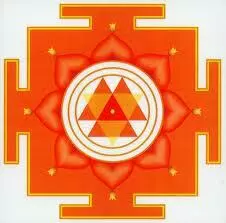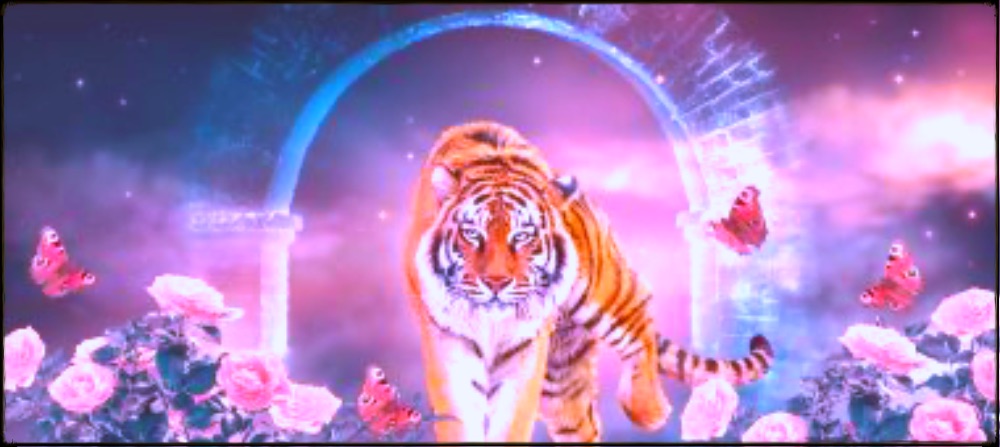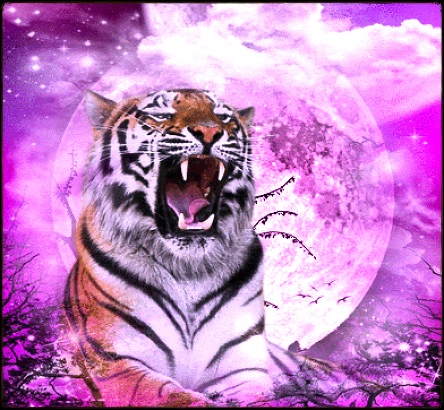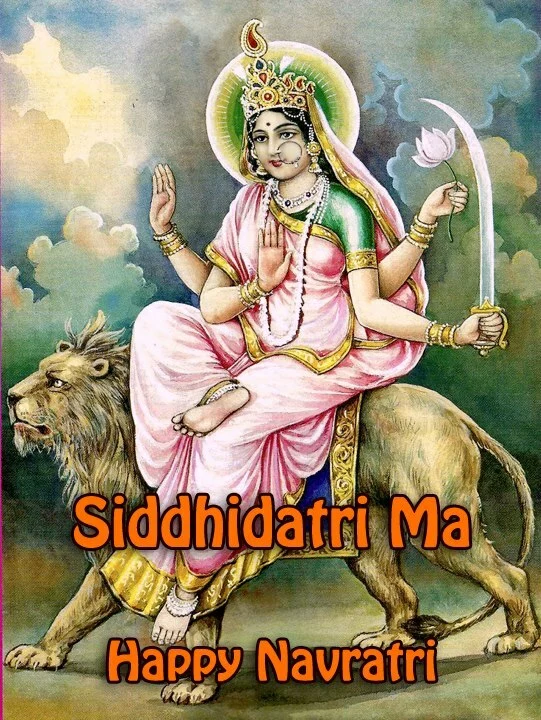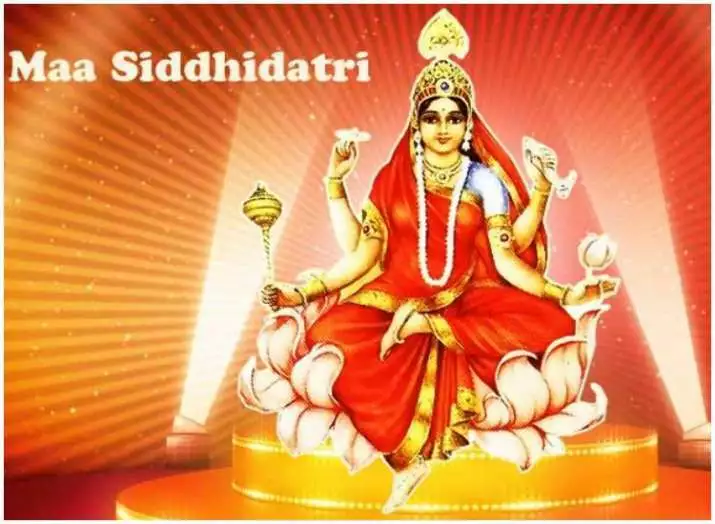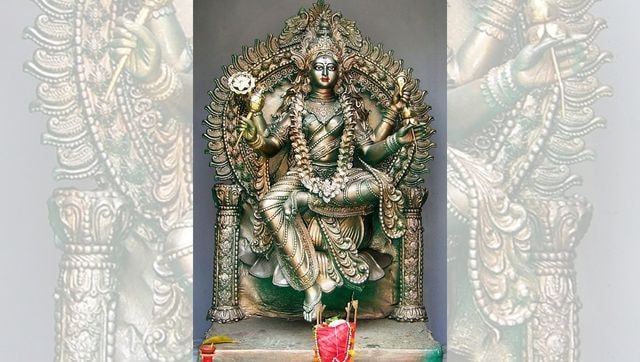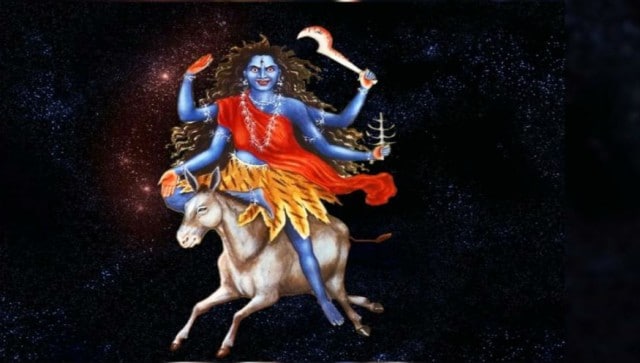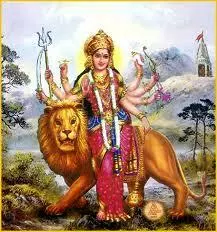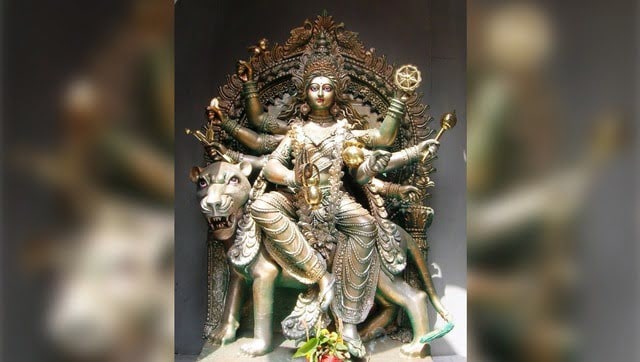#Happy #Navratri Day 10
#Dashami
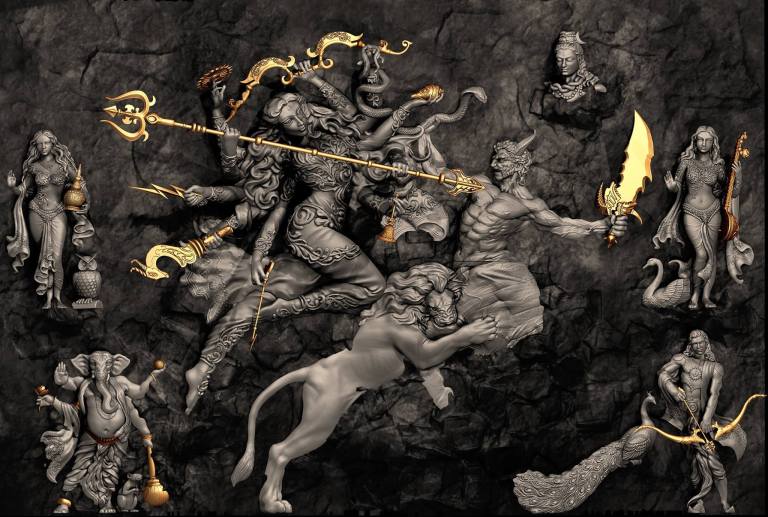
Navratri Parana
31st
March 2023
(Friday)
Chaitra Navratri Parana is performed on the Dashami Tithi of Chaitra Shukla Paksha (bright fortnight of the Hindu month, Chaitra). It is the day when 9-day Chaitra Navratri festival comes to an end.
Though there are contradictory statements in the Shastras to decide if the Parana must be performed on the Navami or Dashami, yet Mimansas (those who have described the Shastras) suggest to perform it on Dashami. They agreed on Dashami Tithi because one can find many texts that suggest keeping fast on Navami.
If Navami Tithi is occurring on 2 days, fast must be kept on the first day and Parana must be performed on the second day of Navami. (It is suggested by the Shastras.)
As it is the last day of Navratri Puja, Bhagwati Durga Visarjan must be performed after Shodashopchar Puja.
After Puja and Visarjan, offer food, gifts, etc. (as per your wish) to the Brahmins. Also, offer these things to the 9 little girls and perform Kanya Pujan.
The Day after NavRatri [the ‘Nine Nights’ of #Goddess #Durga ] is known as Vijaya Dashami / #Dussehra – Victory on the Tenth,the Destruction of Evil.
In many places, the Day is held to commemorate the Victory of Lord Rama over the demon-emperor Ravana. In others, it celebrates the Victory of Durga over Mahishasura. Others still, connect it to the events of the Kurukshetra War of the Mahabarat. The common unifying factor in all of these is, as can be clearly adduced by the name of the occasion, a militant, martially (but also – importantly – piously) attained triumph over the malefic, the a’Rta-ic, the Anaryan.
Now, personally, I tend to fall into the middle camp with my observances. Both due to personal theology and resonance, and because it makes the most sense – to me, anyway – to have this as the effective (post-)culmination of the Nine Nights. Yet with this year’s occasion falling upon a Tuesday (Lord Hanuman’s Day – as well as the day of strong Mangala (Mars)), it is sensible to also have regard for the #Rama relating remembrances, as well.
But those shall not form the focal scope of this piece; which instead seeks to continue the progression of the mythic cycle of Durga as set out through the previous Nine Nights’ worth of commentary – and use this (as well as this lovely devotional (a)art(i) work from Bengal – the original of which is a rather large physical wall sculpture at a Mandir there) as a springboard to talk about the other common feature of Vijayadashami/Dussehra observances, Astra Puja.
I have spoken at some length about both the generalized conceptions of “Dharma-Yuddha”, as well as the more specific struggle against the demon Mahishasur, elsewhere and earlier in the series (in particular, the Katyayani piece, as well as the MahaLaya/Amavasya piece with which we closed Pitru Paksha, to name but two of especial interest); so I shall not seek to repeat much of that material here.
Except to briefly remind readers who may not be so directly familiar with the relevant mythology, that Mahishasur was such a dangerous foe due to a boon he had been granted which rendered him invulnerable to all but a woman – a weakness which he had deliberately chosen (as there had to be some condition to his invincibility, due to the effective nature of Hindu divine legalism in this area), as he has not believed it possible for a female to form much of a martial threat against him.
Which therefore, lead to an escalatingly dire situation for the male members of the Pantheon when They attempted to defend against him … until such point as They invoked the Great Goddess, a most powerful emanation of which – Goddess Durga – took to the field against the demon army, outfitted with panoply of war derived from the customary armaments and iconographic associations of the various (predominantly male) Devas Who had beseeched Her for Aid.
The results of which I have, again, detailed much more expressively elsewhere – but suffice to say, put Mahishasur in a situation wherein his salience upon the battlefield was basically equivalent to “throwing molotovs against Poseidon”. If doing that made Poseidon really, really angry, to the point that Poseidon doesn’t just decapitate the foe, but proceeds to tap-dance vigorously upon the severed head while also continuing to eviscerate the attempting-to-flee spirit of the then-pendingly deceased.
You get the idea.
The core of this element is what’s being depicted in this fine wall-sculpture; with the beautifully enraged Devi Durga, accompanied by Dawon [‘Bravery’ – Her Lion Vahana] lunging at the part-buffalo demonic figure of Mahishasur [likely depicted after he’d … not just figuratively, but literally lost his head – the first one, anyway, with the actual buffalo-ness to it, immediately prior to his extermination via ‘finding himself’ (not via self-realization, but implicit self-destruction through serious arrogance and stupidity) at the [figuratively] wrong end of the Trishula]. The figures around the Combat, are Her Two Sons – Ganesha and Lord Skanda [the martial saliency of Ganesha is often understated – the Gana-Esha, Lord of the Host, epithet is there for a reason; as is the sobriquet around the Remover of Obstacles … via pulverizing and obliterating force, where necessary. Lord Skanda, meanwhile, has a name that rather directly translates as “Assault”, and would perhaps be thought of as our equivalent to Ares]; the two other members of the TriDevi, Lakshimi and Saraswati (Parvati/Durga being the third, as you may have surmised); and looking on from on high, presumably with pride and admiration, Lord Shiva, Moon-Crowned [Chandrasekhara].
Partially, these are standard iconographic accompaniments – especially in the Durga pandalas prominent in Bengal around this time. It is the combination of two of the ‘ordos’ to which Durga is a vital component – the Divine Family of Shiva & Parvati, and the TriDevi that are the Great Goddess(e/’)s Three. Yet it also helps to recall the concept – as considered in far more depth within the ‘Sarva Pitru Amavasya And Devi Mahalaya’ piece with which we presaged NavaRatri this year – that both the manifestation of Durga, and the Victory thusly obtained by the Side of Righteousness against the Anarya, was veer-y much a ‘team effort’, so to speak.
And we shall consider that concept, and how it pertains to exactly why it is that we observe Vijayadashami/Dussehra in just a moment.
Yet before we do, a brief word on two of the relatively more recent symbolic/figurative interpretations of the occasion, derived in no small part in relation to those aforementioned ‘Anaryan’ foes.
The first of these has to be one of the more bizarre spectacles of recent years, and consists of the attempted moves by some minority groups within India to protest against, even to outright block and seek to oppose through legal challenges, the celebration of Durga’s victory over Mahishasur. The reason that they do this, is because they have taken to considering Mahishasura something of a kinsman to them, potentially even an ancestor – and therefore hold that the occasion is, in effect, the glorification of an unmitigated massacre of their forebears by “invading” Indo-Europeans and our War Goddess.
To which I can only retort, that while the Narasimhan et al dna study on ‘The Genomic Foundation Of South And Central Asia’ has yet to conclusively identify a “Demon” haplogroup running around out there in the wild, even if there were somehow a shred of truth to the claims … a) the scriptural materials are quite clear as to just who it was who was seeking to make war upon the heavens, and “indecent propositions” to the Goddess; b) a moment’s consideration will reveal that the appropriate action to undertake, when you find yourself having descended from the monstrosity literally opposing The Goddess at the Heart of the Universe Herself – is a foreswearing of his legacy, a running away from it as fast as possible, and an attempt to live piously and against the grain of his example; not seeking to re-litigate a decisively settled battlefield outcome from an existential war of who knows how long ago, through a series of scattered and basically unsuccessful court actions.
But, then, I’m biased, aren’t I. As, in fact, is the Universe .. Herself.
Anyway, the other somewhat more recent set of developments around the deific and mythoreligious complex in question, concerns the rather more immediate threats posed by historic Islamic invasion, and subsequent British imperial dominion. The latter of which, as we explored in the BHARAT MATA AND THE INDO-EUROPEAN DEIFIC OF NATIONAL IDENTITY, played its part in a bit of a ‘modernizing’ of Devi to more directly link to the emergent Indian ‘national identity’ and nationalist cause of the time [hence Bharat Mata – Mother India; which, to be clear, was an ‘evolution’ veer-y much building upon enduring foundations that were already there, and which had already been ‘developed’ in these directions multiple times, as needed, over the preceding millennia and across the Indo-European-isphere elsewhere in other contexts]; while the former saw the Muslims correlated with Mahishasur, for reasons that ought be obvious.
In both cases, the message was elegant in its complex simplicity: the Nation, as with the Victory, as with the Goddess – is the result of the many, working and pooling together, just as the Gods did when invoking Devi to send/become Durga in Their Midst.
The external threat, the external foe, which could not easily be countered (especially in terms of its cultural impacts and attempted erasure) nor meaningfully subdued through the grand force of the conventional arms of individual soldiers alone (although ShivaJi of the Marathas certainly bucked the trend somewhat on this one – equipped, it must be noted, with the fabled Bhavani Tulwar … the Sword of the Goddess, Herself, given unto him in a manner similar to Excalibur to King Arthur, as a sure sign of Her Divine Favour and his destined re-establishment of Hindu Rashtra [‘Nation’] by fighting back against the Mughals et co.), could be beaten via enduring Piety; via ‘national consciousness’ as a political force (and both this and Heritage as a collective memory); and via the Divine Blessing as seen and secured through the onrolling, unfurling folds of Time. [As a certain Spanish ruler is once said to have remarked – “Time and I, against any other two”. Not for nothing, either, is Kali [‘Time’, amidst other translations .. such as “Death”, “Black[ness]”, “Iron”, etc.], in Hindu terms, reckoned the most fearsome and formidable of foes for the would-be doer of malefic ills]
So how does this relate to the custom of Astra Puja, then, which also occurs upon this day?
Well, at its most obvious, the honouring of weapons [and, to be sure, other implements of one’s societal role and function, too] is the exaltation of the implements, the instruments through which this Victory is attained. And it is an appropriately broad assortment, for an appropriately broad Success. Hence why a journalist may honour his pen, his keyboard, for instance; or an artist, his brushes and easel. And note especially well, for that matter, that Devi also wields amidst Her panoply, a flame with an animal-head therein, to represent Piety, Faith, Sacrifice/Offering/Oblation and Nourishment. Because these are the tools via which the community is protected, exalted, served. And, of course, not forgetting the actual and rather literal weapons also ritually blessed upon this day.
Or, for that matter, that Speech, and all that is entailed and comes with it [learning, communication, thinking, knowledge, conceptry, understanding, shouting roar of divine fury], is the grandest, most mighty weapon of all – and yes, yes we do have the relevant theology to support this statement. Including one of my more fondly recalled instances from the RigVeda in which Brihaspati conjures an orbital bombardment of a demon-dragon via the recitation of a portion of a prayer in the Divine Speech which summons a meteor impact. But again, I digress. Somewhat, anyway – the point is, we exalt this Great Weapon via engagement in the Heritage which is transmitted thence-through, and the utilization, the learning, the uptake, the repetition, and the re-radiance back out again of its forms, role and function.
And this, especially that notion of re-radiance, but also of Speech (Vak), brings us right back to Devi, to Durga, to Parvati, to Shakti.
The course of the NavaDurga Processional, up through the Nine Nights which have preceded this day, is one of Ascension. It begins with Devi as ShailaPutri, newly re-emergent into the World after Sacrifice and Suffering, then arcens back up to the point at which She is once again the glorious World Pillar, the Absolute, the Supreme. This post-ultimate phase is not simply a ‘re-descent’ via emanation, wherein Devi ‘steps back down’ from Her Cosmic (Lion) Throne again … but rather, a tacit and tangible radiating back out of Her Blessings thencefrom, across and into the universal-world. Which, if you recall, is veer-y much the idea contained within the last lines of the justly famed DeviSukta of the RigVeda [RV X. 125. 7-8 , in particular].
To be found also within that same hymnal, of course, are the clear points around both the strong support and empowerment of Rudra especially through His Weapon to make (Holy) war against the enemy of piety; and Devi’s own declaration of Her involvement in such a conflict – both personally, and in terms of rallying and ordering Her (chosen) People in amidst and to the Cause [RigVeda X. 125. 6]; in a suzerainty that is, quite literally, “all-pervading”, from the Summit of the World, down through the worlds, and thence back up again once more to Heaven’s Highest Height.
So on one level, the customs around Astra Puja could be seen as a phenomenon of that wonderful Eliadian concept – the Eternal Return. And they would, of course, be both right and rite. Beyond that particular Vedic verse (which, it must be remembered, also has a rather specific application, as explored in some of the previous commentaries in this series), there are any number of other instances of Astra related rituals to be found within Hindu scripture and broader mythology, after all – including, most prominently, the ’empowerment’ of various arrows and other such weapons to form, as I have occasionally (only somewhat jokingly) termed them, “Ancient Aryan Nuclear Weapons”; as well as, for that matter, the processes via which an aspirant becomes an acknowledged master with his chosen craft of death, and is therefore given a suitably mighty weapon of lore and legend as a result, a symbolic attainment of his greatness as secured through his instrument of will, and to be his instrument of the inscribing of that will across the cosmos in blood and death cracked armour and shards of bone.
And, in a related sense, once we properly and truly perceive the chosen champions of the Goddess as also being Her Weapons – then the notion that we support and empower them in a manner perhaps somewhat symbolically resonant of how the Gods Themselves once did likewise for Her, in Their hour of need, attains additional significance within this spanning sphere of referential perception. As we know from our prior studies in the fields of Myth and Metaphysics, and Meta(physical)Narrativistics quite specifically, the greater the ‘resonancy’ with the greater the ‘concept’, the greater the consequent, contingent, and consecrated the results.
But in the main, I think, and we shall rather rapidly draw things to a close here, so that I may, perhaps (just perhaps) get some sleep before Mandir myself later today … the co-occurrence of Astra Puja and the veneration of MahishasuraMardini [‘Destroyer of the Buffalo[headed Demon’ – a theonym of the Goddess which is directly that of Her role and victory against the aforementioned adversary, Mahishasur] is because they are actually the same phenomenon.
That is to say, Durga, as MahishasuraMardini in particular, is the Weapon of the Gods. The Ultima Ratio Rta’m, so to speak. Against Whom, None can Stand.
She is Called into being for a particular purpose, and ‘wielded’ if you like – on one level, by the combined Pantheon at large Who have invoked Her .. on the greater, truer level, by Herself, especially as Devi (Shakti); and in this age of “Smart Bombs”, and Dumb Politicians, the Weapon which Knows Itself, and is in complete Self Control, is the most formidable prospect, indeed!
The Process of Worship via which She was Called Out To, the Missile Armed [‘Missile’, as in ‘Astra’, which I have quite enjoyed as a word due to its multi-linguistic pun potential with, for instance, “Star” in Latin; although I have also had some resonant success with शस्त्र and शास्त्र – that is to say, weapon/instrument and treatise/field of learning, respectively … except that शस्त्र itself also means “invocation”, “recitation”, as of prayer, thus demonstrating just how coterminous the terms actually are, especially ‘in practice’/actuality/actualization] in multiple senses of the term, some of them rather modern … well, it is exactly that. Astra-Puja. Devi Puja. The continuation of Astral Warfare by any other means.
All things considered, it puts one in the mind of the words of Leonard Cohen –
“I’m guided, by a signal in the Heavens
I’m guided, by this birthmark on my skin
I’m guided, by the beauty of weapons…”
And, of course, to situate things further within the context of Devi – the meaning entailed in the name and form of the Sudarshana Chakra. सुदर्शन, itself, referring to a beatific vision – theophany, perhaps [Darshana], that is radiant .. and, in a weaponized context, radiant in its destruction [ सुदर्शना , with the longer “a” sound upon the end, refers more specifically to a “Beautiful Woman” … other than in application to Devi (Who is Indescribably so), I shall not venture to speculate how that may have eventuated]; while “Chakra”, on one level would refer to the destructive discus-like weapon often associated with Vishnu, on another level, to the Wheel of Time (a truly fearsome weapon, indeed), and potentially also to the circle, the cycle of the universe at large – which is appropriate, considering the Vedic-era symbolism of the Worlds as akin to a chariot-wheel radiating out from the central Axis Mundi; and which therefore underpins part of the Universal Sovereignty concept inherent in “Chakravartin”, as well – She Who ordains the motion of the Wheel that is the World about Her as Its Single Point. [“Guided by The Beauty of our Weapons”, indeed]
But my point is, again, quite a simple one – just as Durga-Parvati, through the Processional of the preceding Nine Nights, had attained once more the World-Axis, the Pleni-Potentiary Situation upon and in-deed As the Summit of the Universe Entire; so, too, does this awesome power thence entail action, an active stewardship and custodian-charge [‘Shakti’ again, in a different sense of ‘power’ … also that Vajra-as-Lightning-Bolt we can see picked out in Gold, there [Which can correlate, interestingly enough, with Vak in certain Vedic contexts, as well]; just as the Trishula, Itself, is the World-Axis, and therefore Her Also. You see? She is the Divine, the Ultimate Weapon, all the way both down and up, still further!].
A “Radiating” out across the Worlds from that Summit [whether as Light, whether as Empowerment(s), or Impartments [e.g. Siddhis], whether as Indirect Efforts through subtle or delicate manipulations, whether as direct issuing of Orders, Edicts, and Directions, or indeed, whether as all that is entailed in the “strong breath like the [somewhat Akashic – Vata] wind and tempest” [RV. X. 125. 8] with accompanying Flight of Arrows, Birds, or Thunderbolts] , and the consequent ‘weaponization’ of that Radiance as a wave-form of Deva-station, Whose ultimate motion is that of one unstoppable, spinning, Dance.
On this day, as we have had ever in our minds for the preceding Nine Nights, we carry out the ultimate Astra Puja. The Request to serve The Gods as Astra; and the Honouring of The Gods for Their Mighty Role Supporting the Ultimate Astra Herself, just as we support Them in Turn.
We Remember the heroic actions of God and Man (a consistent theme with the ‘Sarva Pitru Amavasya And Devi Mahalaya’ which immediately presaged the Nine Nights, also); We Recollect the sparks of inspiration from Heritage and from History to be found even amidst the brighter lustre of Day; We Retrench ourselves, in preparation for the next phase of the oncoming Dharma-Yuddha;
And – above all – We Remember, and thence Re-Immanentize, Why we need It, and why It Needs us.
जय माता दी ॥
जय जय हे महिषासुरमर्दिनि रम्यकपर्दिनि शैलसुते ॥
“We are the Mail about HER Fist…”
https://aryaakasha.com/2019/10/08/the-tenth-day-the-death-of-the-demon-dussehra-vijayadashami/



